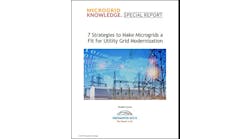Proposed Decision Moves California Closer to Making $200M Available for Community Microgrids
A much-awaited community microgrid incentive program appeared to move a step closer to becoming a reality in California last week with the release of a proposed decision by an administrative law judge (ALJ).
Written by ALJ Colin Rizzo, the document attempts to resolve several outstanding details before the California Public Utilities Commission surrounding the distribution of the $200 million for community microgrids (Docket No. 19-09-009).
Before the commission since late 2021, the utility-designed plan has widespread support. But microgrid advocates have been frustrated by the pace of regulatory approval. In August, the Microgrid Equity Coalition urged the commission to take action, noting the need for microgrids in a state plagued by wildfires and public safety power shut-offs (PSPS).
Once approved, the program will send the money to disadvantaged and vulnerable areas of the state that face grid outages. The state’s three investor-owned utilities — Pacific Gas & Electric (PG&E), Southern California Edison (SCE) and San Diego Gas & Electric (SDG&E) — crafted the program under an order by the commission. It is part of a larger strategy to help commercialize microgrids as directed by a state law enacted in 2018.
The $200 million is divided among the three utilities with PG&E providing $87,200,000; SCE, $91,340,000; and SDG&E $21,460,000. Utilities would be able to use 10 percent for administrative costs.
The utilities expect the program to produce complex microgrids able to provide multiple properties with power during lengthy grid outages. Communities are eligible for the money if they experience PSPS events, high wildfire risk, or exceptionally poor grid performance. Communities also can qualify that are vulnerable to damaging earthquakes.
One issue that the proposed decision attempts to resolve is when money should be allotted to cover technical assistance. The plan provides grants of $25,000 to communities to cover development costs. The Microgrid Equity Coalition and the Green Power Institute say the commission should provide communities with the money to help them prepare their applications — otherwise poorer communities might not be able to afford the technical assistance to prepare the application.
ALJ Rizzo also recommended that project deadlines be eased to give communities more time to build the microgrids. Originally they were allotted 24 months to get the microgrids operating, but the proposed decision says the deadline should be extended as needed.
Given that the microgrids will be complex, a tight deadline “would likely only support projects that are currently under development and could aggressively compete for money,” Rizzo wrote, which is “incongruent” with the program’s intent. At the same time, Rizzo rejected a request by Clean Coalition, a non-profit microgrid developer, that would require utilities to interconnect the microgrids within a specific timeframe, citing a lack of experience with community microgrids on both the utility and applicant side. Microgrid developers frequently complain that it takes too long to win interconnection approval from utilities.
The proposed decision also:
- Outlines status reports and other filings the utilities must make to show progress on the community microgrids.
- Resolves various budget allocation, cost recovery and ratemaking issues.
- Weighs in on the tool to be used that would determine where the community microgrids should be built.
- Resolves business plan requirements, scoring methods and outside funding issues.
- Settles issues pertaining to community engagement for project solicitation, dispute resolution, and leftover funding.
The commission may rule on the microgrid incentive program, at the earliest, during its March 16 business meeting.
Interested in learning more about the California community microgrid incentive program? Join us May 16-17 in Anaheim, California for Microgrid Knowledge 2023: Lights On!








